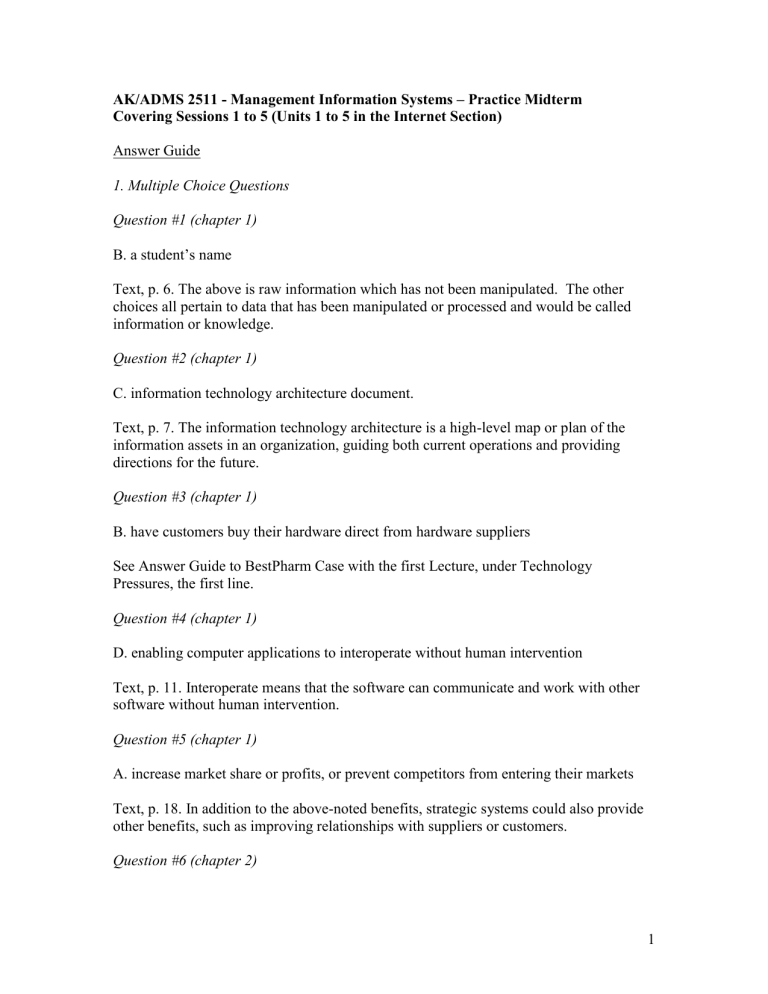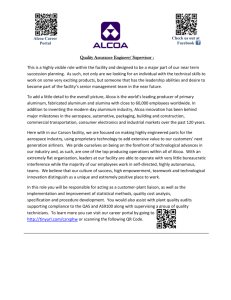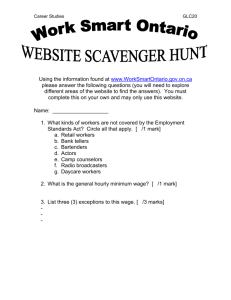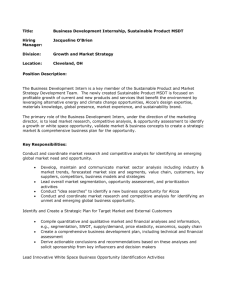AK/ADMS 2511 - Management Information Systems

AK/ADMS 2511 - Management Information Systems – Practice Midterm
Covering Sessions 1 to 5 (Units 1 to 5 in the Internet Section)
Answer Guide
1. Multiple Choice Questions
Question #1 (chapter 1)
B. a student’s name
Text, p. 6. The above is raw information which has not been manipulated. The other choices all pertain to data that has been manipulated or processed and would be called information or knowledge.
Question #2 (chapter 1)
C. information technology architecture document.
Text, p. 7. The information technology architecture is a high-level map or plan of the information assets in an organization, guiding both current operations and providing directions for the future.
Question #3 (chapter 1)
B. have customers buy their hardware direct from hardware suppliers
See Answer Guide to BestPharm Case with the first Lecture, under Technology
Pressures, the first line.
Question #4 (chapter 1)
D. enabling computer applications to interoperate without human intervention
Text, p. 11. Interoperate means that the software can communicate and work with other software without human intervention.
Question #5 (chapter 1)
A. increase market share or profits, or prevent competitors from entering their markets
Text, p. 18. In addition to the above-noted benefits, strategic systems could also provide other benefits, such as improving relationships with suppliers or customers.
Question #6 (chapter 2)
1
A. a knowledge worker.
Text, p. 37, provides examples of specific jobs for each of these types of employees.
Question #7 (chapter 2)
A. knowledge workers
Text, p. 37 explains that business intelligence software is used by primarily knowledge workers and middle managers.
Question #8 (chapter 2)
C. support the use of simulations
Text, p. 37. DSS quite often deal with projected data and “what if” scenarios and use simulations, which use data specific to the decision (not data flow as in A) and require flexibility (contrary to B). This requires analysis, contradicting D. The text uses the phrase “advanced ‘what if’ analysis and simulations.”
Question #9 (chapter 2)
D. instructions about how to combine hardware, software, databases and networks in order to process and output information.
Text, p. 34. The purpose of procedures in the context of a computer-based information system is to help ensure that all components listed above , i.e. above the procedures
(hardware, software, database and network) function together as designed.
Question #10 (chapter 2)
D. application programs.
Text, p. 34. Such programs are programs (or systems, i.e. groups of programs) that support a task or process. Application programs is a term that is also used to describe systems that support a particular area, such as accounts receivable or sales.
Question #11 (chapter 3)
B. property.
Text, p. 65. The first question listed in Table 3.1 under the heading of property issues is
“who owns the information?”
Question #12 (chapter 3)
2
A. a code of ethics.
Text, p. 64. Responsibility is a concept that cannot easily be regulated. Standards are also regulated, but tend to be more specific than principles. The text explains that a code of ethics is a collection of principles.
Question #13 (chapter 3)
C. establish both a privacy policy and procedures to ensure that the policy is adhered to.
Text, p. 68. Above is one of the characteristics of this legislation, as described in the text.
Question # 14 (chapter 3)
C. Temporary because the organizational connection exists only during transmission
Text, p. 91. They are temporary as they are initiated when the transmission occurs, then terminated.
Question # 15 (Technology Guide 3)
D. your financial exposure
Text, p. 377 and session materials. The protective actions that you take should be based upon the size of your bank account and credit limit – your financial exposure, as it takes only one internet connection, one infected email, or a few minutes for someone to access your information.
Question # 16 (Technology Guide 3)
B. file a detailed police report
Text, p. 378. The police report is important so that you will have supporting evidence for credit agencies, creditors and others to indicate that you have been a victim of identity theft.
Question # 17 (chapter 4)
B. one byte of storage.
Text. p. 110. A single byte represents a character or number. As the decimal number “7” is one character, the answer is one byte.
3
Question # 18 (chapter 4)
A. Relational database
Text, p. 114. This page explains that a single relational table could also be called a “flat file,” a term that is also used to describe traditional systems. When multiple twodimensional tables are linked using database management software, they become a relational database.
Question # 19 (chapter 4)
A. Normalization
Text, p. 115. Normalization helps to remove redundant data elements, helping to provide better operational performance.
Question # 20 (Session 4 )
C. Simplicity of operation
Overhead in Session/Unit 4 titled “Traditional File Environment.” This explains that such systems are simpler and can provide faster processing speed.
Question # 21 (chapter 4)
D. A unique identifier of the event or entity
Text, p. 111. A primary key helps to locate a record or other piece of information by providing a unique identifier.
Question # 22 (Technology Guide 4)
A. Connect parts of the intranets of different organizations
Text, p. 412. The definition of an extranet is that it “connects parts of the intranets of different organizations and allows secure communications among business partners over the Internet using virtual private networks.”
Question # 23 (Technology Guide 4)
D. Is open only to users who belong to the network
Text, p. 412. Such networks use passwords or encryption with digital keys.
4
Question # 24 (Technology Guide 4)
D. An intranet
Text, p. 412. An intranet is a network designed to serve the internal informational needs of a single organization. As discussed in lecture material, such intranets often use World
Wide Web standards.
Question # 25
C. Field
Text, p. 110, which holds a logical grouping of characters or of information.
Question # 26 (Technology Guide 4)
B. URL (uniform resource locator)
Text, p. 415. The URL helps the user access web sites.
Question # 27 (chapter 5)
A. Affinity portal
Text, p. 142, used for communities such as hobbies or political parties. The York
University student alumni group is given as an example in Figure 5.3
Question # 28 (chapter 5)
D. Voice-over internet protocol
Text, p. 144. Also known as VoIP or Internet Telephony, analog voice signals are converted. Where digital telephone lines are present and digital telephones are in use, the analog conversion is no longer required.
Question # 29 (Lecture notes that accompany Chapter 5)
C. Data sent via the Internet is not private
Refer to overhead titled: “WWW Risks or Disadvantages (continued).”
Question # 30 (Chapter 1)
B. sales invoice
5
Text, p. 6. Information refers to data that has been organized: on a sales invoice you will find information about the customer and products that has been arranged into an invoice to charge a customer. The other choices in the question each contain only a single data element which has not been organized in any particular way.
Question # 31 (Chapter 2)
D. customer-orientation strategy
Text, p. 43. Methods of “making customers happy” include providing personalized service that is one-on-one.
Question # 32 (Chapter 3)
C. poor passwords
Text, p. 75. Poor passwords are those that are easy to guess, such as your name or your telephone number.
Question # 33 (Chapter 4)
A. customer information in the sales systems cannot be accessed by other applications
Text, p. 109. This type of data isolation occurs with traditional or functional systems, rather than systems that are integrated, such as with an ERP (enterprise resource planning) system.
Question # 34 (Chapter 4)
D. data warehouse
Text, p. 119. Since the data warehouse is created by transferring historical data from multiple databases or files on a periodic file, the data is first made consistent, and then is kept in the data warehouse without changes until the next update.
Question # 35 (Chapter 5)
B. internet
Text, p. 157. SOA (service-oriented architecture) uses the internet to deliver transaction processing capabilities and other functions to organizations.
6
Question 2 (Greenville Hospital)
[Note that definitions need to contain the principle ideas associated with the system type.
Some definitions require multiple concepts to obtain full marks. Normally, part marks
(such as ½ marks) are NOT awarded. ]
TPS – Transaction Processing System
Definition: (1 mark)
(text, page 36, 38) Transaction Processing Systems: support the monitoring, collection, storage, and processing of data from the organization’s basic business transactions, each of which generates data.
(1 mark – example loosely tied to Greenville hospital – three possible examples shown)
- billing system to bill patients
- payroll system to pay employees
- accounts payable to pay suppliers
OAS – Office Automation System
Definition: (1 mark)
(text, page 37, 38) Office Automation Systems: support clerical staff, lower and middle managers, and knowledge workers. (Support daily work activities of individuals and groups.)
(1 mark – example loosely tied to Greenville hospital – three possible examples shown)
- word processing to prepare employee announcements
- e-mail to inform employees of recent events
- electronic calendars to schedule appointments and meetings
MIS – Management Information System
Definition: (1 mark)
(text, page 37, 38) Management Information Systems: summarize data and prepare reports from transaction data based upon specific criteria (usually in one functional area).
(1 mark – example loosely tied to Greenville hospital – three possible examples shown)
- analysis showing profitability of work done by doctors
- schedule showing overtime by employee to manage overtime hours
- list of inventory items in the pharmaceutical area by nursing station (potentially to show items that are low and need to be reordered)
7
DSS – Decision Support System
Definition: (1 mark)
(text, page 37, 38) Decision Support Systems: support advanced “what if” analysis and simulations.
(1 mark – example loosely tied to Greenville hospital – two possible examples shown)
- analysis of costing alternatives for developing a new wing
- looking at alternative suppliers costs to decide who should replace the beds (hospital materials)
SIS – Strategic Information System
Definition: (1 mark)
(text, page 39) Strategic Information Systems: provide a competitive advantage by helping an organization implement its strategic goals and increase its performance and productivity.
(1 mark – example loosely tied to Greenville hospital – two possible examples shown)
- new patient information system that allows doctors to access electronic patient records from their offices or from anywhere within the hospital using the internet (improving effectiveness of patient care)
- new prescription labelling system and prescription label scanning system so that each dose is scanned and matched to the label (improving accuracy of prescription drug delivery by nurses, i.e. delivery of a dose on the ward)
Question 3 (Big Bakery)
(one mark for each step of the ethical framework, and one mark for each valid point stated under each step, to a maximum of 10 marks, with an internal maximum of three marks for each step of the ethical framework. Note that many different answers are possible here) Source – Session 3 or Unit 3 Overheads.
1. Obtain the relevant facts
- your supervisor has asked you to code all rejected sales transactions batches as code 5
(eastern division) when many of these batches will be for other divisions
- this will increase the bonus for division 5 (eastern) and decrease the bonus for other divisions
2. Identify the ethical issues from the facts
- you are being asked to deliberately code transactions incorrectly
- this not only results in incorrect bonuses, but incorrect sales figures
- you are being asked to be dishonest about recording the sales figures
8
3. Determine who is affected by the outcome and how (1 mark for identifying both the stakeholder and the needs/wants of the stakeholder – only ½ mark if the stakeholder is identified without a need/want. Full marks for additional reasons under a particular stakeholder)
Myself:
- don’t want to get in trouble for recording incorrect information (I might be the ‘fall guy’ if this is discovered, as the supervisor)
- if I do what my boss says, I will get a higher bonus
- I could get fired if I don’t do what my boss says
My boss:
- is behaving in an unethical manner and I will get in trouble if I report him
- my boss could get fired if I report him
The other employees in my division (Eastern):
- are earning bonuses that they don’t deserve
- think that their division is doing better than it really is
The employees in other divisions:
- are earning less bonuses than they deserve
- think that their division is doing worse than it really is
Management:
- may be evaluating the divisions incorrectly and making incorrect management decisions about costs and employees
Investors:
- may think that something is wrong with management if the divisions sales/costs are so out of whack
4. Identify reasonable alternative actions (one mark for the action, one mark for the impact of the action)
Tell my boss that I’m not going to do it:
- I might get fired
- my boss might clean up his act and do things properly
Code them properly but not tell my boss:
- I might get fired
Tell my boss that I’m not going to do it and that if he pushes me I’ll report to senior management (or something like that):
- I might get fired
- my boss might clean up his act and do things properly
Write an anonymous letter to management asking them to look into the matter, or report via a whistle-blowing program, if it exists:
- we might all get fired (i.e. whole operations department)
Start looking for a job right away, quit, then report the issue to upper management:
- this way I don’t get fired, and I have a regular job
5. Identify the potential consequences of your options (included above in step 4)
6. Take appropriate action
9
(one mark for an appropriate decision, and then additional marks supporting the decision, assuming it has been reasonably supported).
Question 4 (Alcoa)
A) What is a supply chain? (1 mark)
(text, page 36) It describes the flow of materials, information, money and services from suppliers of raw materials through factories and warehouses to the end customers.
Define an intranet. (1 mark)
(text, page 412) The intranet is an internal network for use by a single organization.
OR
It is an internal network that uses the internet and web-based standards.
Provide four examples of how Alcoa could use an intranet for improving its decision making with respect to inventory or sales. (4 marks)
[The text suggests (p. 412) that the intranet supports activities around discovery, communication and collaboration. 1 mark for each valid point raised below, other examples are possible.]
- the intranet could be used to coordinate sales to the same customer in multiple countries, i.e. have a bulletin board that lists information for sales representatives
- sales representatives could post information about new customers for use by other locations
- sales presentations or tips could be posted for use by other individuals
- the intranet could be used to post information such as online training courses for sales staff or names of individuals with specific expertise with certain kinds of customers
- tips on inventory handling or efficiency techniques could be posted on the intranet
B) For each of the following e-commerce business models, briefly describe the business model and explain how Alcoa would implement the business model (by providing an example tailored to the business model) (4 marks)
(1 mark for the explanation and 1 mark for statements that relate to the example for each type. See text pg. 175 for description of e-commerce business models.)
Electronic tendering system
10
Description: businesses request quotes from suppliers, using B2B (business-tobusiness e-commerce) with a reverse auction mechanism.
Examples:
- Alcoa could place on its extranets a description of contracts that it would like to fill (for example, a cleaning service, or the fabrication of aluminum products into certain products, such as aluminum foil, or for packaging materials).
- suppliers would log into the extranet and provide bids for the contracts or services that they are prepared to provide to Alcoa and how much they want to be paid for these services
- Alcoa would notify suppliers which contracts were accepted, and indicate where more information was needed to decide upon which contracts should be accepted
Affiliate marketing
Description: vendors ask partners to place logos or banners on a partner’s site. If sales take place due to these advertisements, then the partner site receives commission on the sales.
Examples:
- Alcoa could place on its web site a description and prices of the products that it has available for sale. Vendors or business partners are allowed to place banners on Alcoa’s web site to advertise their products.
- when users of Alcoa’s web site click on the vendor or business partner web site, they are transferred to the vendor or business partner web site
- should a user of Alcoa’s web site purchase products from a company that uses a banner ad, then Alcoa will receive a commission
Question 5 (Toshiba)
Relational database management system
Def’n: (text, p. 114), max 2 marks
- treats data as if it is stored in two-dimensional tables
- usually designed with a number of related tables (normalization does this)
- information from tables can be extracted and combined, providing flexibility (done by means of the primary key)
Suitability: Yes.
Support: max 3 marks
there is a high level of flexibility for organizing and searching data (‘ad hoc queries’) so that both internal and external data could be organized
it is easy to understand, visualize, design and maintain
11
can handle multiple types of data
can be expanded to a multi-dimensional system, if needed
reduces data redundancy as normalization means that only key fields in the joined tables are duplicated
reduces data isolation as all authorized users can access the same information
reduces data inconsistency as only one copy of the data (plus the key field) is stored in the tables
Data warehouse
Def’n: (text, p. 119) max 2 marks
- a repository of historical data that are organized by subject to support decision makers in the organization
- an architectural structure that defines how historical data is stored
- typically uses multidimensional data structure
Suitability:
Yes.
Support: max 3 marks
- data is organized by business dimension or subject
- data is cleansed/sanitized for inconsistencies (i.e. consistent)
- data is optimized for rapid access using OLAP (online analytical processing)
- the company would have information from all of its divisions in one data stucture
- the data would be formatted the same way so could be readily compared
Could also argue NO:
- very costly and complex to establish (hardware, software and people costs)
- requires continual maintenance as supporting applications change
- requires high levels of security to ensure access is to authorized users only
- data is NOT the system of record since historical data is transformed to go into it
12







